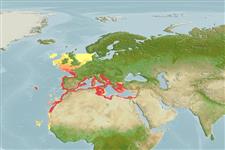Teleostei (teleosts) >
Eupercaria/misc (Various families in series Eupercaria) >
Sparidae (Porgies)
Etymology: Pagellus: Diminutive of Latin, pager, derived from Greek, pagros = a fish, Dentex sp. (Ref. 45335).
More on author: Risso.
Environment: milieu / climate zone / depth range / distribution range
Ecology
Marine; benthopelagic; oceanodromous (Ref. 51243); depth range ? - 500 m (Ref. 4781), usually 40 - 100 m (Ref. 35388). Subtropical; 58°N - 12°N, 26°W - 36°E
Eastern Atlantic and Mediterranean Sea: Bay of Biscay to Senegal, Madeira, the Canary Islands, Cape Verde; rare in the British Isles but recorded occasionally off Denmark. Azores (Ref. 44330).
Length at first maturity / Size / Weight / Age
Maturity: Lm 15.0 range ? - ? cm
Max length : 36.0 cm SL male/unsexed; (Ref. 4781); common length : 25.0 cm SL male/unsexed; (Ref. 4781)
Adults inhabit various types of bottoms, especially seagrass beds and sand down to 500 m depth, but more common between 40 and 100 m. The young are found nearer to the shore. Omnivorous, but prefer worms, mollusks and small crustaceans (Ref. 3688). Important food fish.
Most individuals are first males, then become females at a size of about 24 to 30 cm (Ref. 2715) or 17 to 29 cm TL; 2 to 7 years (eastern Atlantic and Mediterranean Sea) (Ref. 4781). Also Ref. 28504.
Bauchot, M.-L. and J.-C. Hureau, 1990. Sparidae. p. 790-812. In J.C. Quero, J.C. Hureau, C. Karrer, A. Post and L. Saldanha (eds.) Check-list of the fishes of the eastern tropical Atlantic (CLOFETA). JNICT, Lisbon; SEI, Paris; and UNESCO, Paris. Vol. 2. (Ref. 3688)
IUCN Red List Status (Ref. 130435)
Threat to humans
Harmless
Human uses
Fisheries: commercial; gamefish: yes
Tools
Special reports
Download XML
Internet sources
Estimates based on models
Preferred temperature (Ref.
123201): 12 - 18.4, mean 14.8 °C (based on 156 cells).
Phylogenetic diversity index (Ref.
82804): PD
50 = 0.5156 [Uniqueness, from 0.5 = low to 2.0 = high].
Bayesian length-weight: a=0.01096 (0.00949 - 0.01266), b=3.06 (3.03 - 3.09), in cm total length, based on LWR estimates for this species (Ref.
93245).
Trophic level (Ref.
69278): 3.8 ±0.0 se; based on diet studies.
Generation time: 3.7 (2.6 - 5.2) years. Estimated as median ln(3)/K based on 10
growth studies.
Resilience (Ref.
120179): Medium, minimum population doubling time 1.4 - 4.4 years (K=0.17-0.23; tm=2-3; tmax=7; Fec=85,000).
Prior r = 0.59, 95% CL = 0.39 - 0.88, Based on 1 full stock assessment.
Fishing Vulnerability (Ref.
59153): Moderate vulnerability (37 of 100).
Climate Vulnerability (Ref.
125649): High vulnerability (62 of 100).
Nutrients (Ref.
124155): Calcium = 119 [60, 236] mg/100g; Iron = 0.555 [0.324, 0.940] mg/100g; Protein = 19.6 [18.5, 20.9] %; Omega3 = 0.45 [0.29, 0.67] g/100g; Selenium = 81.7 [36.5, 172.1] μg/100g; VitaminA = 13.2 [3.2, 61.8] μg/100g; Zinc = 0.485 [0.358, 0.728] mg/100g (wet weight); based on
nutrient studies.
